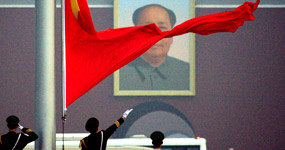
世界已习惯了中国时刻不停的变化步伐。又是一年过去了,又是一个10%的增长。但与那些通过在门柱上划上印记、以此监测青春期子女“疯长”情况的父母一样,记录中国的变化有其意义。这不仅仅是一个记录中国增长的问题。实际上,我心目中的一些重要事件很难加以衡量。的确,在这一年里,以美元计算的中国经济规模超过了日本,2010年肯定会因此而载入史册。但在其它一些方面,过去的一年也将被视为中国复兴的关键。下面,就是我在“门柱”上所做的7个“印记”,排序不分先后。
皱眉外交:在这一年,中国区域性的“微笑外交”变成了皱眉外交。这可能有些夸大其辞。中国更为强硬的姿态,在一定程度上是对美国政府试图更积极地重新参与亚太地区事务的回应——美国提出在围绕中国南海的争议中进行斡旋,就是这方面的一个例证。中国政府将此举视为一种干涉。这使得中国评论人士提出,整个中国南海地区都属于“核心利益”,不容谈判,不能与台湾和西藏相提并论。在另一场围绕中国东海钓鱼岛的争议中,中国政府更为尖利的抗议声吓住了日本政府——此前,日本拘捕了一为驾船撞击日本船只的中国渔船船长。一些担心被强大的中国抛弃的亚洲外交人士,正努力拉拢美国更全面地介入亚洲一些羽翼未丰的机构组织。
谷歌(Google):当谷歌威胁要撤出中国时,中国已准备迫使这家美国公司亮出底牌。换言之,通过撤离中国这个全球规模最大——不过利润水平并非最高——的互联网市场,谷歌也准备逼迫中国政府亮出底牌。无论从哪个角度说,中国对跨国公司的态度已经开始改变——中国曾渴望获得这些公司的投资和技术。在吸收了大量外国技术之后,中国现在似乎正在打造一种有利于本土企业的竞争环境。
火车:中国今年不仅仅是在增长,它也在“缩小”。由于迅速的投资,中国高铁网络的覆盖面积,已超过全球其它国家的总和。从武汉到广州1068公里的旅程,现在只需要3个小时,而去年需要10个小时。正如英国《金融时报》一篇lex专栏所指出的那样,从芝加哥到纽约的类似旅程,需要18个小时。2008年也是如此。
人民币:中国政府继续抵制人民币的升值压力。今年,人民币兑美元汇率累计上涨2.5%。远为重要的,是中国加速人民币国际化所运用的标准。意义最为重大的改变,是允许海外银行和央行投资与中国银行间债券市场,这让它们有理由首先持有人民币。海外的人民币数额相对较少,但增长极为迅速。马来西亚央行或许并非唯一一家资产负债表上有人民币资产的央行。
刘晓波:如果把中国比作一个十来岁的孩子——对于全球文明古国之一,某种意义上这是一种无助的比喻——那么中国对今年诺贝尔和平奖(Nobel Peace prize)的反应,就是他“摔门掷气”的时刻。对这一奖项不理不睬的做法会好一些。更好的做法是,中国可以(用大量合理的理由)解释,中国民众的自由度已有了明显提高。而最好的办法是把刘晓波放掉,中国政府可以在不影响多数国人眼中其合法性的情况下做到这一点。
稀土:今年,世人意识到中国控制着全球97%的稀土,它是电器、汽车和军工行业的重要原料。中国企业目前正以前所未有的热情,疯狂购买其它矿产资源,增加煤炭、铜、铁矿石和石油的贮存量。分析师表示,中国最聪明的策略是悄然累积探矿权,其争议性要小于开采中的矿山和油田。10年之后我们可能会发现,中国主宰的不仅仅是稀土生产。
富士康(Foxconn):这是最深的一个印记。华南地区拥有30万员工的富士康工厂曝出的一系列员工自杀事件,不仅导致中国内地部分劳动人口加薪20%至25%,还提出了对廉价民工模式的质疑——在过去30年,这一模式推动了中国的经济增长。其结果是,许多国家(从柬埔寨到印尼)都经历了制造业——以及制造业薪资——的上升。就中国而言,较为贫困的内陆省份将出现更多的工业发展,同时将不那么强调出口驱动型增长。
其中的一些趋势,在亚洲邻国的国防部以及美国跨国企业的董事会里,正引发人们的焦虑。但我们不要夸大其辞。实际上,中国崛起所造成的摩擦非常之少。在让数亿人摆脱贫困方面,中国的成功值得称道。近来,讨论崛起后的中国已成为一时之风尚。这有些言之过早。目前,中国不过是从过去200年的酣眠中�醒。当中国真正崛起时,人们将不需要在门柱上划下印记。你会知道关于她的一切。
译者/何黎
http://www.ftchinese.com/story/001036153

The world has grown used to the restless pace of change in China. Another year, another 10 per cent. But like a parent who monitors an adolescent’s growth spurt by making notches on the doorpost, there is something to be said for keeping track. This is not merely a matter of recording China’s growth. In fact, the milestones I have in mind are harder to measure. Certainly this was the year that, in dollar terms, China’s economy surpassed Japan’s, a moment that will ensure 2010 a place in the history books. But in other ways too, the past year will be seen as crucial in China’s renaissance. Here, in no particular order, are seven notches on the doorpost.
Frown diplomacy: This was the year China’s regional “smile diplomacy” turned into a frown. This can be overstated. Beijing’s more assertive stance came partly in response to Washington’s attempt to re-engage more actively in the region, exemplified by its offer to mediate in disputes centred on the South China Sea. Beijing sees this as interference. It has allowed Chinese commentators to raise the idea that the whole South China Sea is a “core interest”, making it non-negotiable on a par with Taiwan and Tibet. In a separate dispute, over the Senkaku/ Diaoyu islands in the East China Sea, Tokyo was taken aback by Beijing’s shriller tone after its arrest of a Chinese fisherman for ramming a Japanese vessel. Some Asian diplomats – scared of being left alone with a robust China – are trying to draw the US more fully into the region’s fledgling institutions.
Google: China was prepared to call Google’s bluff when the US company threatened to withdraw from the country. Put another way, Google was prepared to call Beijing’s bluff by pulling back from the world’s biggest – though not most profitable – internet market. Either way, China has begun to take a different attitude to the multinational companies whose investments and technology it once craved. Having absorbed much foreign technology, it now seems to be tilting the playing field in favour of its own companies.
Trains: China did not only grow this year. It also shrank. Thanks to rapid investment, China’s high-speed rail network is already more extensive than the rest of the world’s combined. A 1,068km journey from Wuhan to Guangzhou takes just three hours, against 10 hours in 2009. As Lex points out, a similar length journey, between Chicago and New York, takes 18 hours. So 2008.
Renminbi: Beijing continued to resist pressure to revalue the renminbi. In 2010, the Chinese currency appreciated all of 2.5 per cent against the dollar. Far more important were the measures China took to speed up internationalisation of its currency. Most significant was a change that allowed offshore banks and central banks to invest in China’s interbank bond market, giving them a reason to hold renminbi in the first place. The amounts of offshore renminbi are small, but exploding. Malaysia’s central bank is probably not the only one to hold part of its balance sheet in “redbacks”.
Liu Xiaobo: If China is a teenager – in some ways an unhelpful metaphor for one of the world’s oldest civilisations – then its reaction to this year’s Nobel Peace prize was its door-slamming moment. It would have been better simply to have ignored the award. Better yet, Beijing could have explained (with much justification) how much freer China’s population has become. Best of all would have been to release Mr Liu, something it could have done without risking its legitimacy in the eyes of most Chinese.
Rare Earths: This year, the world woke up to the fact that China controls 97 per cent of rare earths, an important input in the electronics, automotive and arms industries. Chinese companies are now on an unprecedented buying spree of other mineral resources, picking up deposits of coal, copper, iron ore and oil. Analysts say its cleverest tactic is its quiet accumulation of prospecting rights, less controversial than working mines and oilfields. In 10 years’ time we may discover China dominates more than just rare-earth production.
Foxconn: The deepest notch of all. A spate of suicides at a Foxconn site employing 300,000 in southern China not only triggered wage rises of 20-25 per cent across parts of the Chinese labour force, it also raised questions about the cheap migrant-labour model that has turbocharged growth for 30 years. Other countries from Bangladesh to Indonesia are seeing a pick-up in manufacturing – and manufacturing wages – as a result. For China, there will be more industrial development in poorer inland provinces and less emphasis on export-led growth.
Some of these trends are causing anxiety – in defence ministries of Asian neighbours and boardrooms of US multinationals. But let us not overdo it. China’s rise has actually caused remarkably little friction. Its success in drawing hundreds of millions out of poverty is to be celebrated. Recently, it has become fashionable to talk about a risen China. This is premature. China is only now recovering from the torpor of the past 200 years. When China has truly risen, there will be no need to make notches on the doorpost. You will know all about it.
没有评论:
发表评论